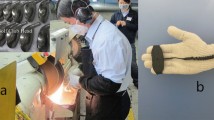Abstract
Objectives
To assess the usefulness of color charts for the diagnosis of finger whiteness in vibration-exposed workers.
Methods
A group of 146 forestry and stone workers exposed to hand-transmitted vibration (HTV) were examined twice over 1 year follow up period. The anamnestic diagnosis of finger whiteness was made on the basis of (a) a medical history alone, and (b) the administration color charts which showed changes in the skin color of fingers and hands. The cold response of digital arteries was assessed by measuring the change in finger systolic blood pressure (FSBP) after local cooling from 30 to 10°C (FSBP%10°).
Results
Assuming the administration of color charts as the gold standard, the sensitivity and specificity of the medical history alone to diagnose finger whiteness was 88.2 and 93.8%, respectively, at the initial cross-sectional study and 94.4 and 97.7% at the end of the follow-up. Random-intercept linear regression analysis of follow up data showed that after adjustment for several covariates, FSBP%10° was significantly associated with finger whiteness assessed by either medical history alone (P < 0.005) or the color charts (P < 0.001). However, a statistical measure of overall fit of regression models (Bayesian Information Criterion) suggested that the color chart method performed better than medical history alone for the prediction of the cold response of digital arteries.
Conclusion
The administration of color charts seems to reduce the proportion of false positive responses for finger whiteness in a population of vibration-exposed workers. The color chart method was a more significant predictor of digital arterial hyperresponsiveness to cold than medical history alone. These findings suggest that the use of color charts in clinical and epidemiological studies may be of help to assist in the diagnosis of finger whiteness in vibration-exposed workers.
Similar content being viewed by others
References
Bovenzi M. Hand-transmitted vibration (1998) In: Stellman JM (ed) Encyclopaedia of occupational health and safety, 4th edn, vol II. ILO, Geneva, pp 50.7–50.12
Brennan P, Silman A, Black C, Bernstein R, Coppock J, Maddison P, Sheeran T, Stevens C, Wollheim F (1993) Validity and reliability of three methods used in the diagnosis of Raynaud’s phenomenon. The UK Scleroderma Study Group. Br J Rheumatol 32(5):357–361
Gemne G, Pyykkö I, Taylor W, Pelmear PL (1987) The Stockholm Workshop scale for the classification of cold-induced Raynaud’s phenomenon in the hand–arm vibration syndrome (revision of the Taylor-Pelmear scale). Scand J Work Environ Health 13:275–278
Griffin MJ (1990) Handbook of human vibration. Academic, London
Griffin MJ, Bovenzi M, Nelson CM (2003) Dose-response patterns for vibration-induced white finger. Occup Environ Med 60:16–26
International Organization for Standardization (ISO) (2001) Mechanical vibration—measurement and evaluation of human exposure to hand-transmitted vibration—part 1: General requirements. ISO 5349-1. ISO, Geneva
Maricq HR, Weinrich MC (1988) Diagnosis of Raynaud’s phenomenon assisted by color charts. J Rheumatol 15(3):454–459
Nielsen SL, Lassen NA (1977) Measurement of digital blood pressure after local cooling. J Appl Physiol 43:907–910
O’Keeffe ST, Tsapatsaris NP, Beetham WP Jr (1992) Color chart assisted diagnosis of Raynaud’s phenomenon in an unselected hospital employee population. J Rheumatol 19(9):1415–1417
Olsen N, Hagberg M, Ekenvall L, Futatsuka M, Harrison J, Nasu Y, Welsh C, Yamada S, Yoshida M (1995) Clinical and laboratory diagnostics of vascular symptoms induced by hand–arm vibration. Report from discussions in a working group. In: Gemne G, Brammer AJ, Hagberg M, Lundström R, Nilsson T (eds) Proceedings of the Stockholm workshop 94. Hand–arm vibration syndrome: diagnostics and quantitative relationships to exposure. National Institute of Occupational Health, Solna, 25–28 May 1994. Arb Hälsa vol 5, pp 181–186
Raftery AE (1996) Bayesan model selection in social research. In: Marsden PV (ed) Sociological methodology. Basil Blackwell, Oxford, pp 111–163
Acknowledgments
This research was supported by the European Commission under the Quality of Life and Management of Living Resources programme, Project No. QLK4-2002-02650 (VIBRISKS).
Author information
Authors and Affiliations
Corresponding author
Additional information
Work presented at the Second International Workshop 2006 on Diagnosis of Hand–Arm Vibration Syndrome in Göteborg, Sweden.
Rights and permissions
About this article
Cite this article
Negro, C., Rui, F., D’Agostin, F. et al. Use of color charts for the diagnosis of finger whiteness in vibration-exposed workers. Int Arch Occup Environ Health 81, 633–638 (2008). https://doi.org/10.1007/s00420-007-0248-2
Received:
Accepted:
Published:
Issue Date:
DOI: https://doi.org/10.1007/s00420-007-0248-2




